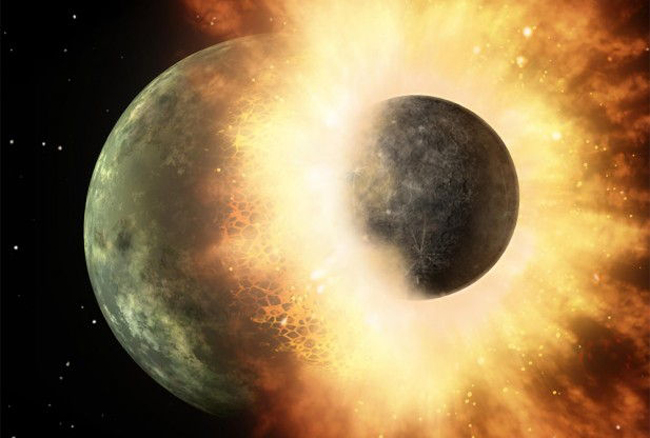Earth-Moon Smashup Happened Earlier Than Thought

SACRAMENTO, Calif. — Earth's moon sprung to life much sooner than scientists thought, new research suggests.
Previously, scientists had pinned down the moon's birth at 100 million years after the solar system formed 4.568 billion years ago. New findings push back the moon's birth date to just 40 million years after the solar system coalesced, researchers said yesterday (June 10) here at the annual Goldschmidt geochemistry conference.
The leading theory for how the moon was born suggests it originated from a Mars-size body slamming into Earth. Though the collision was only a glancing blow, the giant impact destroyed the impacting planet, called Theia. The resulting debris became the moon, though Earth also contributed some rubble. [The 5 Biggest Mysteries of Earth's Moon]
To calculate when this giant impact took place, geochemists Guillaume Avice and Bernard Marty analyzed xenon gas trapped in tiny bubbles in ancient quartz from South Africa and Australia. The quartz bubbles from South Africa and Australia retain the chemical signature of Earth's atmosphere from when the bubbles formed, like a time capsule from 3.4 billion and 2.7 billion years, respectively.
The amount of xenon isotopes (atoms with different numbers of neutrons) in the quartz is different than it is today. There's more xenon in the older rocks, because the noble gas has slowly escaped into space since the Earth's atmosphere formed.
"The Earth has a finite reservoir of xenon, and xenon is escaping from this reservoir to outer space," Avice said.
By measuring how much xenon is in today's atmosphere and comparing it to past levels in the ancient rocks, Avice and Marty gauged how much gas was present in Earth's earliest atmosphere. Their model assumes that all of Earth's gases (also called volatiles) were blown away by the impact.
Sign up for the Live Science daily newsletter now
Get the world’s most fascinating discoveries delivered straight to your inbox.
"The xenon chemistry dates the last time when Earth didn't have any atmosphere," said Avice, a doctoral student at the Centre de Recherches Pétrographiques et Géochimiques in France.
And the only event powerful enough to remove Earth's atmosphere was a planetary impact, the researchers said. The early solar system was a violent place, and models suggest the young Earth underwent up to a dozen massive blows from other planet-size objects — which helped Earth boost its size — before the final smash that spawned the moon. Later impacts were too small to strip the atmosphere, Avice said.
If some of Earth's atmosphere remained after the Earth-Theia impact, as some models suggest, then the new xenon age would shift toward a date of 100 million years after the solar system formed, instead of the younger age of 40 million years after the formation of the solar system, Avice told Live Science.
However, other studies to be presented at the conference this week also found signs of an earlier Earth-moon impact. So, evidence is building that the catastrophic collision that formed the moon occurred earlier than 100 million years after the solar system formed, which could reshape models of how the Earth formed.
"This might seem a small difference, but it is important," said Marty, a professor at the University of Lorraine in Nancy, France. "These differences set time boundaries on how the planets evolved, especially through the major collisions in deep time which shaped the solar system."
For instance, an earlier Earth-moon birth date changes the planet's thermal history, said Richard Carlson, a geochemist at the Carnegie Institution for Science in Washington, D.C.
"The interesting part about these results, at least to me, is how young the moon is turning out to be," said Carlson, who was not involved in the study. "The ages of moon formation of 50 [million] to 100 million years after solar system formation imply that the giant impact could have been very late in Earth's accretionary history, which could have some interesting, and different, consequences for the thermal evolution of the Earth than if the impact had occurred earlier in the history of Earth's accretion."
Email Becky Oskin or follow her @beckyoskin. Follow us @livescience, Facebook & Google+. Original article on Live Science.










